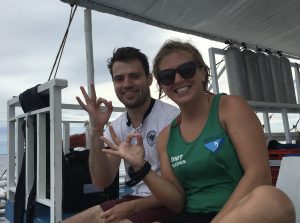As I think back on the last four weeks of my Divemaster course, it’s as though I’ve just had the most amazing dive and now I am holding the line at the five-meter mark and counting down my three-minute safety stop. There were so many colourful, rare and interesting things to see and learn along the way and I’m sad that it’s nearing the end. I have just a few more exercises to do before I have to ascend those last few meters and climb out of the water.
First up are anxiety-inducing swim tests. Every time I read the requirements – a 500m swim with no assists and an 800m swim with snorkel, mask and fins (all within a certain time) – I curse myself for never having learned how to do a proper front crawl. While I am the owner of a mean doggy-paddle, my front crawl is embarrassingly weak and does not include putting my face in the water. I’ll have to rely on my determination and a few instructional You Tube videos to get me to the finish line on time. The purpose of this exercise is to check whether the trainee is physically fit. After six months travelling around Asia on holiday, the result will be informative to both my instructor and myself.
Also remaining on the to-do list is an equipment exchange with a buddy under water. Sounds easy, right? Not so fast. We have to trade our BCD/tank, mask and fins while sharing just one air source. That means that while my buddy exhales his breath, I breathe from the regulator and peel off a piece of equipment as fast as I can. I then give him the regulator and I exhale while he gets out of his equipment. Piece by piece, we trade gear while trying not to choke on water or panic. This should be fun! The purpose of such a strange task? Would you ever need to do this underwater? Highly unlikely. The real purpose is to test how well I manage stress and whether I can keep calm while doing something difficult under the surface.
After all, the job of a Divemaster can be stressful. Leading a group of divers – all possibly at different skill levels – into the blue is a big responsibility. While, technically, the role of a Divemaster is to show certified divers cool aquatic life and ensure their guests have a great time, this also means keeping them safe. Strong currents, poor buoyancy, and low-air, for example, can all quickly become serious challenges. Of course, a Divemaster knows how to avoid these situations but they must also know how to manage them if they occur. While the equipment exchange tests the student, it also helps prepare them should they ever have to manage a stressful situation under the water.
The last of my tasks before the end of the course is to map a dive site. With my fellow Divemaster trainee Cat, we’ve been counting our fin kicks and checking our compass routinely at local dive sites. While my instructor will tell you otherwise, mapping is not an easy task. At least not for the directionally-challenged, like me. Strong currents at Deep Rock also prevent me from going the full way around the pinnacle and the sheer size of North Point inevitably leaves Cat mapping only part of the site. However, we persist, dive the sites a few more times, and dutifully sketch our maps.
With these three tasks completed, my Divemaster course will be finished. It seems like just yesterday I arrived on Malapascua Island but in reality it was seven weeks and three courses ago. My three-minute safety stop will soon be over and I’ll have to ascend out of the blue. I suppose it’s true what they say; time flies when you’re having fun.

